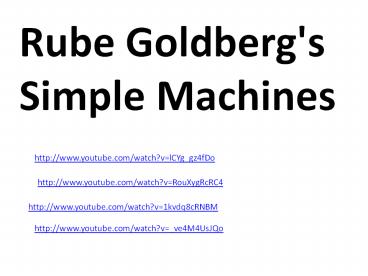Rube Goldberg's Simple Machines PowerPoint PPT Presentation
1 / 16
Title: Rube Goldberg's Simple Machines
1
Rube Goldberg's Simple Machines
http//www.youtube.com/watch?vlCYg_gz4fDo
http//www.youtube.com/watch?vRouXygRcRC4
http//www.youtube.com/watch?v1kvdq8cRNBM
http//www.youtube.com/watch?v_ve4M4UsJQo
2
Students will learn about the six simple
machines, play some online games, write problems
calculating mechanical advantage and design and
construct a working model of a Rube Goldberg
machine using at least three of the six simple
machines. Introduction The goal of this webquest
is to allow you to extend your knowledge of
simple machines beyond our time in the classroom.
You will do this by learning about a man named
Rube Goldberg who drew complicated cartoons to
accomplish a simple task. You will work both
individually and as a group with the students at
your science table. Collaboration during class is
an extremely important part of this project.
3
Task Your task is to design and build a
three-dimensional Rube Goldberg Machine that uses
at least 3 different types of simple machines to
accomplish one task. You may use as many of
each type of machine as needed. (For example, you
may use 3 levers, 2 pulleys and 1 inclined
plane.)
4
Process For this project there will be individual
assignments and a group assignment. Make sure you
complete your individual assignments so that you
are ready and able to help your partners complete
the group assignment. TASK 1 Gaining Information
- individual Visit the following websites to gain
information about the project. Simple Machines
information http//www.edheads.org Click on
simple machines and START. Go to the HOUSE and
visit all the rooms. Print out your score for at
least one room.
5
Rube Goldberg information http//www.rubegoldberg
.com Visit the Artwork Gallery
6
Rube Goldberg EXTREME examples http//www.koreus.
com/video/incredible-machine.htmlhttp//www.stee
lcitysfinest.com/HondaAccordAd.htm
7
Mechanical Advantage Problems Examples
http//go.hrw.com/resources/go_sc/hst/HSTMW531.P
DFhttp//www.oecta.on.ca/curriculum/structures/
grade8/8st4bl3.pdf
8
TASK 2 - Preliminary Designs - individual Design
a Rube Goldberg Machine that will fit on the top
of your science table. You must use 3 different
types of simple machines but you can use as many
of them as you want. Bring ideas and sketches to
class to share with your partners. You will have
several times during the next couple of weeks to
do this.
9
TASK 3 - Design Collaboration - group Bring ideas
and sketches to class to discuss with your group.
You will have 15 minutes at the beginning of each
class to work together on the final design.
10
TASK 4 - Final Design - group Complete final
design diagram. Determine what materials are
needed to complete the machine. Make a materials
list. Determine which of the materials each
member can bring from home. Use simple materials
found at home - be creative.
11
TASK 5 - Mechanical Advantage Problems -
individual Make up three word problems for each
of the following simple machines lever, pulley
and inclined plane 2. Type/write them neatly and
solve each one showing your work.
12
TASK 6 - Building the Machine - group Build the
machine in class with materials brought from
home. Must follow design diagram. Be of sound
construction It must work by the end of the
class!
13
Date Created October 28, 2007
CATEGORY 20 points 15 points 10 points 5 points
Final Diagram Diagram is clear and greatly adds to reader's understanding of machine. Diagram is clear and easy to read. Diagram is somewhat clear and easy to read. Diagram is difficult to read and understand.
Model-Construction Sound construction with no problems. Sound construction with minor problems. Construction has major problems. Poorly constructed.
Model-Design Follows design. Follows design most of the time. Follows design somewhat. Does not follow design.
Model-Creativity Highly creative. Creative. Somewhat creative. Shows no creativity.
Working Model Working Model Works most of the time. Works some of the time. Not a working model.
Personal Sketches Personal sketches and ideas are present
Mechanical Advantage Problems Problems typed/written neatly, work is shown and solutions are present. Problems typed/written neatly, work is not shown but solutions are present. Problems are not neat, work is not shown but solutions are present. Not mechanical advantage problems.
EdHeads Print out EdHeads print out with name and score is present.
Collaboration during planning All members always provided useful ideas while participating in planning. Most members provided useful ideas while participating in planning. Some members provided useful ideas while participating in planning. Members rarely provided useful ideas while planning. That is - one member of the group did all the work.
Collaboration during building All members worked well and put forth great effort. Group worked well and put forth good effort. Some of the group worked well and put forth some effort. Group did not work well and did not put forth much effort.
14
Conclusion The following is a list of products
you must turn in for credit. Individual Your
original design/sketches/ideas - even if your
design wasn't chosen by the group. EdHeads print
out. Mechanical Advantage problems. Group Final
Design Diagram - with names of all members of the
group Working Machine
15
Credits PermissionsWe all benefit by being
generous with our work. Permission is granted for
others to use and modify this WebQuest for
educational, non-commercial purposes as long as
the original authorship is credited. The modified
WebQuest may be shared only under the same
conditions. See the Creative Commons Attribution
Non-Commercial Share-Alike license for details.
This WebQuest was created in QuestGarden
16
(No Transcript)

